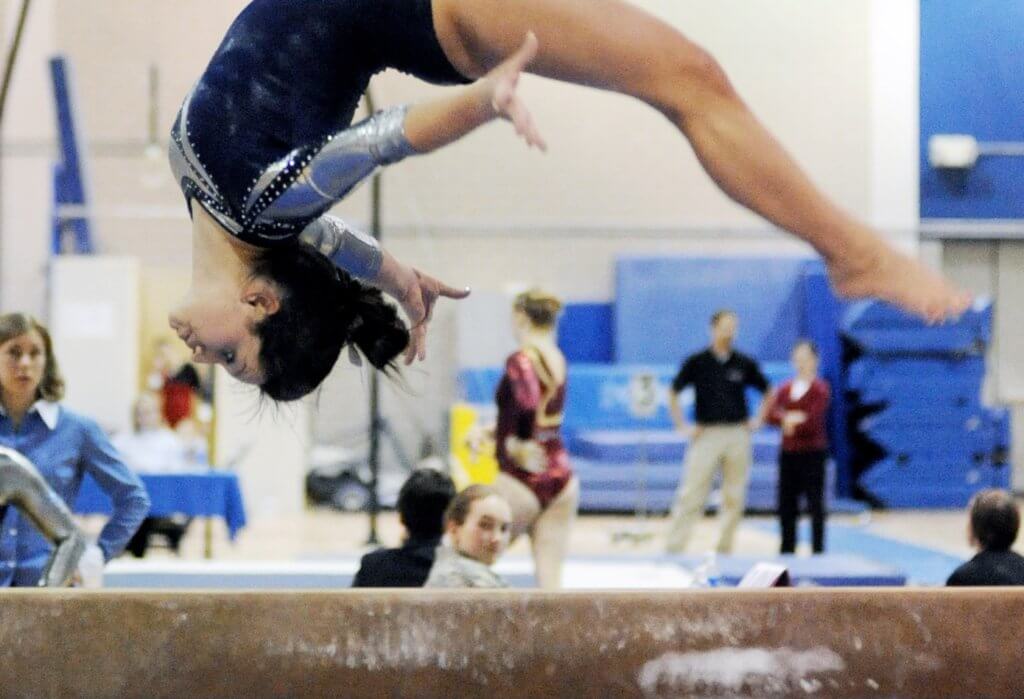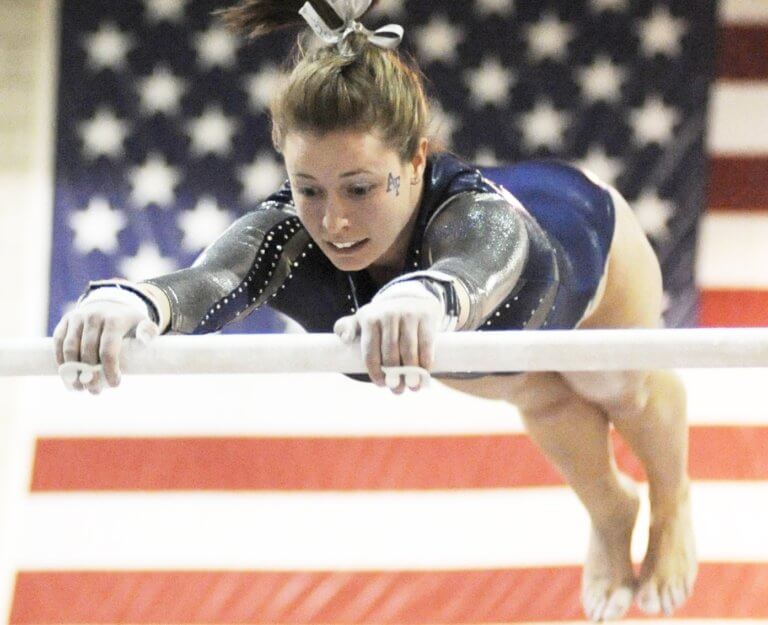What are the most difficult gymnastics skills in the world?
The most difficult gymnastics skills combine power and grace to produce jaw dropping movements.
As gymnastics software developers we’re amazed by these feats. We’re also deeply appreciative of the inspiration that top gymnasts provide for young athletes across the world.
That’s why we’ve collected 14 of the most difficult gymnastics moves ever completed by women in competition. These skills are sure to inspire. They include moves like the Jurkowska-Kowalska on beam, the Biles and Biles II on floor, the Produnova on vault, and many more.
We hope you enjoy learning about them as much as we enjoy watching them!

What are the most difficult gymnastics skills on beam?
The beam is a piece of gymnastics equipment that requires extreme precision. Even the best gymnasts in the world may lose their balance on something as innocent looking as a split jump. The hardest gymnastics skills on beam include dismounts and jumps completed solely on the apparatus, like the Back-full.
Back-full (beam)
Description: A standing back salto tucked with a full twist (360°). The Back-full is not a dismount off the beam, rather it’s a skill completed on the beam, which means it takes a great deal of precision. If the gymnast is thrown off axis by even a fraction of an inch, they may miss their landing and fall to the floor.
In order to create enough power to complete this maneuver, some gymnasts will link a back handspring into the Back-full. However, in the video below you’ll see Gabby Douglas complete a flawless Back-full from stand-still. It’s an incredibly impressive show of strength.
Origin: The first women’s gymnast to complete the Back tuck with a full twist was Aleftina Pryakhina of the former Soviet Union, at the 1986 Jr. Europeans.
Level of Difficulty: F (5.613)
Video:
The Jurkowska-Kowalska (beam dismount)
Description: A gainer salto layout with two full twists (720°) completed as a dismount off the beam. This skill is frightening to launch into. Unlike many beam dismounts in which gymnasts launch themselves straight off of the beam, the Jurkowska-Kowalska requires that gymnast launch themselves up and begin flipping backwards while traveling forward off the beam. Add in two full twists and this feat is dizzying to master!
Origin: The first women’s gymnast to complete the gainer layout with two full twists was Katarzyna Jurkowska-Kowalska from Poland at the 2018 World Championships in Doha Qatar.
Level of Difficulty: E (6.507)
Video:
Full-in (beam dismount)
Description: A double back salto tucked or piked with a full twist (360°). One of the most difficult parts of this dismount is generating enough power and height to complete the skill. The floor and the vault are two apparatus that allow a gymnast to generate speed and power to complete complex flipping movements. However, the beam affords only a short and extremely narrow runway that produces no natural spring. Completing a double back salto with a full twist requires a massive amount of speed and power.
Origin: The first women’s gymnast to complete the double back salto tucked with a full twist was Jiang Wei of China. Astoundingly, Jiang Wei was only 12 years old when she landed this dismount at the 1980 USA vs China competition.
Level of Difficulty: G (6.705)
Video:
The Biles (beam dismount)
Description: The Biles on beam is a double back salto tucked with two full twists (720°). This dismount takes the Full-in beam dismount (above) and increases the difficulty by including another full-twist. Similar to the Full-in dismount, one of the most challenging parts of this skill is generating the speed and power to complete the movement with control. Adding an extra twist to the Full-in arguably makes the Biles (or the “double-double”) the hardest dismount to complete on beam. It’s no surprise then, that the only women’s gymnast to ever land this dismount is Simone Biles.
Origin: Simone Biles from the U.S.A. was the first women’s gymnast to complete the skill at the 2019 U.S.A. Gymnastics Championships in Kansas City, U.S.A..
Level of Difficulty: H (N/A)
Video:
What are the hardest gymnastics skills on floor?
Gymnastics routines on floor present a mixture of artistic movements and powerful tumbling skills. There is no beam, vault, rings or any other apparatus for the gymnast to navigate. For this reason, the hardest gymnastics skills on the floor truly push the limits of what the human body can do on its own.
The Biles (floor)
Description: Double salto layout with a half-twist (180°). This skill requires a high degree of core strength to maintain the layout position while completing two flips at high velocity. On top of the strength required to complete this movement, it also requires a high degree of technical skill because of the blind landing. A blind landing means the gymnast does not have the opportunity to see the ground while inverted. As a result, the skill is highly dependent on muscle memory and control. Mid-air adjustments are not an option!
Origin: American gymnast Simone Biles landed the first double salto layout with a half-twist in 2013 at the World Championships in Antwerp.
Level of Difficulty: G (5.703)
Video:
The Silivas (floor)
Description: A double back salto tucked with two full twists (720°). It takes a great deal of finesse to intertwine two twists with two flips. However, this skill is also dependent on generating enough power to launch the athlete high enough in the air to complete their rotations and flips with control. The Silivas remained the most difficult gymnastics skill on floor for 25 years, before Victoria Moors completed the skill in the layout position (see The Moors II below).
Origin: The double salto tucked with two full twist was first completed by Romania, Daniela Silivas at the 1988 Olympics in Seoul, Korea.
Level of Difficulty: H (5.802)
Video:
The Moors II (floor)
Description: The Moors II is a double salto with a double twist (720°) in layout position. Much like the Silivas above, the double-twisting double layout requires an enormous amount of power generated by the gymnast in order to gain the appropriate height to complete both flips and both twists. The layout position of this skill increases the difficulty immensely because the inertia of these flips and twists naturally forces a gymnast to bend their knees. The gymnast must therefore be extremely strong to counteract these forces and remain in layout position.
If you watch closely, gymnasts who execute this skill poorly, typically cannot counteract inertia and complete the skill with slightly bent knees and flexed feet – as opposed to completing the layout with straight legs and strong, pointed toes.
Origin: The first gymnast to land the double-twisting double layout in competition was Canadian, Victoria Moors in 2013 at the World Championships in Antwerp.
Level of Difficulty: I (5.903)
Video:
The Biles II – Triple-double (floor)
Description: A double back salto tucked with a triple twist (1080°). The Biles II is the most difficult women’s gymnastics skill ever completed on floor. This movement adds an additional twist to the Silivas which was the most difficult gymnastics move for a quarter of a century. Gymnasts attempting the triple-double are required to generate even more power in order to gain enough airtime to complete this skill with control. It wouldn’t be surprising to see this skill stand as the hardest gymnastics skill in women’s gymnastics floor routines for the next 25 years.
Origin: Simone Biles from the U.S.A. was the first women’s gymnast to complete the skill at the 2019 U.S.A. Gymnastics Championships in Kansas City, U.S.A..
Level of Difficulty: J (N/A)
Video:
What are the most difficult gymnastics skills on vault?
Unlike floor, beam, and most other areas of practice, there is no routine on vault. This means gymnasts can’t make up for any slips or falters. The vault only gives gymnasts one shot to execute their skill.
The Cheng (vault)
Description: A roundoff entry onto the spring board with a half-twist onto the table and a front salto layout with one and a half twists (540°) before landing. This vault is rarely attempted in women’s gymnastics due to its difficulty. The Cheng requires gymnasts to complete a round-off onto the spring board, giving them a blind entry onto the vaulting table. In other words, when the gymnast hits the springboard, they’re carrying the full speed of their run and the power of the round-off backward, towards a vault table they can’t see.
The front salto with one and a half twists off the table must then be completed by carrying upward momentum from their blind twisting entry. It’s much more complex than simply generating a straight line of power from the springboard to the vault and then up in the air to complete more common vaulting skills.
Origin: Cheng Fei of China was the first women’s gymnast to ever complete the vault, in 2005 at the World Championships in Australia.
Level of Difficulty: (6.0)
Video:
The Biles (vault)
Description: A round-off entry onto the spring board with a half-twist onto the table and a front salto layout with two twists (720°). The Biles takes the extreme difficulty of the Cheng and adds another half twist. Not only does this increase the difficulty of the movement by requiring the gymnast to complete another half turn, it also drastically increases the difficulty because they gymnast lands blind. As a result, the Biles on vault is tied as the second most difficult vault to complete.
Origin: This skill was first performed by American gymnast Simone Biles at the 2018 World Championships in Doha, Qatar.
Level of Difficulty: I (6.40)
Video:
The Produnova (vault)
Description: Known as the “Vault of Death”, the Produnova vault is a front hand-spring onto the vault table with two tucked front saltos off the vault. Previously the Produnova was listed at a higher level of difficulty but the scoring was readjusted after complaints that gymnasts who poorly executed the Produnova were scoring far higher than those who precisely executed less difficult vaults. Although it’s scoring has decreased this vault, it is still tied with The Biles as the second most difficult vault to compete.
Why is the Produnova vault so difficult? Because the vault requires a massive amount of power in order to complete both tucked saltos. Furthermore, the entire skill is completed blind. The front handspring onto the vault and both saltos only allow the gymnast to glimpse the floor for a fraction of a second during the first half of a salto which means the landing depends completely on timing and muscle memory.
The Produnova has been criticized because of the high potential for injury. However, despite its danger, every so often a gymnast will compete internationally using the Produnova. Most recently, Dipa Karmakar from India successfully completed the Produnova at the Rio Olympics in 2016. If you’d like to read more about Dipa Karmakar, you can see her profile in our female role models article.
Origin: Yelena Produnova was the first gymnast to complete this vault at the 1999 World Championships in Tianjin, China.
Level of Difficulty: I (6.40)
Video:
The Yurchenko Double Pike (vault)
Description: A round-off onto the springboard with a back handspring onto the table, followed by a piked double salto off the vault. Much like the Biles II on floor (the triple-double), the Yurchenko Double Pike Vault has only ever been completed by men. This vault is a high-difficulty skill with only five male gymnasts ever competing it.
There are several reasons why this vault is so difficult. First and foremost, the gymnast has to generate significant power to hit the fault and spring high enough to complete two piked saltos. Harnessing that power in a piked position directly contradicts what the human body naturally wants to do when flipping backward. When completing a back salto of any kind, the body naturally wants to open up into more of a flat position. This means it requires extra strength and technique to hold that straight-legged pike position. Lastly, completing two piked backflips creates a great deal of spinning force which the gymnast then has to absorb and control as their feet hits the mat.
Origin: This skill was first performed by American gymnast Simone Biles at the 2021 United States Classic in Indianapolis, U.S.A..
Level of Difficulty: N/A (6.60)
What are the most difficult gymnastics skills on uneven bars?
Uneven bars are the place where gymnastics can truly soar. While dismounts are high-flying and strenuous, we’ve picked two flights as the most difficult gymnastics skills on bars.
The Def (bars)
Description: The Def is a Gienger release move with an extra full twist. In simpler terms, the Def is a skill completed on the uneven bars where the gymnast releases the bar, completes a back salto layout with one and a half twists (540°) before catching the bar again.
Origin: The first women’s gymnast to complete the move in international competition was Snejana Hristakieva at the 1992 World Championships in Paris, France. However, the creator of this skill was a French gymnast named Jacques Def. Although traditionally a skill is named after the first person to complete it in competition, it’s believed that because “Def” is easier to say than “Hristakieva” the skill is most commonly referred to as The Def.
Level of Difficulty: G (3.705)
Video: n/a
Shaposhnikova (bars)
Description: A hip circle on the low bar past the hand-stand position to a flight release with a full twist (360°) before catching the high bar. In the full-twisting Shaposhnikova the gymnast begins on the low bar with her back to the high bar. After the flight release and full twist are completed, the gymnast catches the high bar in a similar position, with her back to the bar. The difficulty of this move is magnified with a blind catch from low bar to high bar.
Origin: Russian gymnast Aliya Mustafina was the first women’s gymnast to complete the skill, at the 2013 World Championships in Antwerp.
Level of Difficulty: (N/A)
Video:
So, what is the hardest gymnastics move in the world?
As Simone Biles continues to rack up new amazing skills, this question becomes harder to answer!
In the spring of 2021 Biles completed a brand new vault for women’s artistic gymnastics, the Yurchenko Double Pike vault. And to us, this is now the hardest gymnastics move in the world.
Why?
This skill has initially been awarded the highest level of difficulty of any vault which is a good reason to name it the hardest gymnastics skill in the world. But, beyond that, it’s important to remember that this vault is so difficult, no other woman has even tried it in competition.
Previously, we named the Produnova vault the most difficult skill in women’s artistic gymnastics due to it’s high risk and difficulty. But, several women have competed that vault, unlike the Yurchenko Double Pike vault.
So, for now, and the foreseeable future, we think Yurchenko Double Pike vault is the most difficult gymnastics move in the world.
The Future of Women’s Gymnastics Skills
We’re excited to see what the future holds for women’s gymnastics. Simone Biles continues to up the ante with more powerful skills that were previously out of reach. What will she doe next? And who will the next innovator be? Will they reinvent the most difficult gymnastics moves? To read more about athletes redefining their sports, see our definitive list of female athlete role models.
If you’re a gymnastics club owner, administrator or coach, you can learn more about how Uplifter can help your gymnasts develop their skills with our athlete tracking, registration and club management software.









